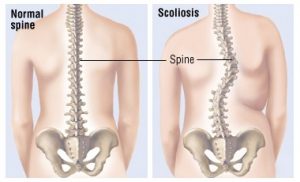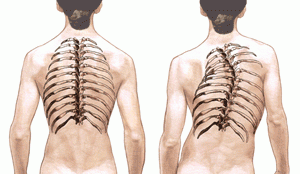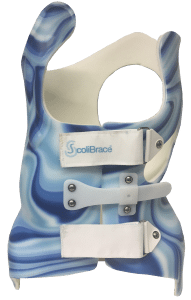What Is Scoliosis?
Scoliosis is most commonly known as “curvature of the spine” which is a sideways (lateral) curvature of the spine apparent when you are looking from the front or the back. It also involves a twisting rotation of the body and often straightening of the spinal curves from the side view.
Types Of Scoliosis
Scoliosis is typically classified according to its cause and time of life it develops or is diagnosed. Children can be born with it for a variety of reasons and it may be due to spinal malformations. It can be caused by bone weakening diseases and underlying nervous system diseases or pathologies.
Most scoliosis is classified as “Idiopathic” which means the exact cause is unknown or more importantly the cause is multi-factorial. Juvenile idiopathic scoliosis onsets between 3 and 9 years while adolescent idiopathic scoliosis onsets between 10 and 15 years.
Adolescent Idiopathic Scoliosis
Adolescent Idiopathic Scoliosis is the most common form of scoliosis occurring in 3% of adolescents. It develops between the ages of 10 and 15 years and is typically more common in girls than boys. It is essential during these years that children are checked as it is during large growth spurts that curves can rapidly progress. It typically does not cause back or neck pain and mostly parents and adolescents are unaware of its presence. Thus, it is essential that adolescents are screened at this time and not wait until curves become more pronounced. Smaller curves are much easier to treat than larger curves.
Adolescent Idiopathic scoliosis has a high hereditary genetic component. Thus, if it is present in the extended family, adolescent’s are at a higher risk. It is more 12 times more common in ballet dancers and rhythmic gymnasts, the actual reason for this is unknown but it is thought that it could be associated with the asymmetrical spinal loading and growth alterations caused by the postures and movements required.
Degenerative or “De-Novo scoliosis”
Scoliosis can also develop in adults with no known history of scoliosis and it is known as Degenerative or “De-Novo scoliosis”. It affects approximately 30% of adults over the age of 60 and it is due to ligament weakening in the spine and degeneration causing the vertebra to progressively mis-align or subluxate. It can often cause significant pain and disability and may often not respond to traditional chiropractic or physiotherapy treatment. However recent developments in bracing and exercise rehabilitation can offer patients a new solution.
How To Check For Scoliosis?
The easiest way to check for scoliosis is have the person wear their underwear or swim wear.
You then look for:
- Are the shoulder’s level or uneven?
- Is the waist even on each side? Or is one side more straight and the other more rounded or prominent?
- Are their hips level when viewed from the front or the back?
- In senior’s, does one side look like it’s folded down with a large skin crease?
- Are the shoulder blades level? Does one stick out more than the other?
- With straight legs, have them bend forward from the waist and put their hands between their knee’s if possible and look to see if one side of the rib cage is higher than the other or the lower back is more prominent than the other. This is a check for spinal rotation.
If you look at 0ur scoli-screen app, it will help to walk you through the scoliosis check.
Treatment For Scoliosis
Treatment for scoliosis will always depend on the cause.
Scoliosis that is caused by underlying neuromuscular or neurological conditions will require different treatment to those that are caused by birth defects, spinal degeneration and ligament weakening or idiopathic forms.
Our treatment is focussed upon teaching scoliosis specific exercise and bracing with the ScoliBrace system when indicated. Worldwide research studies have shown bracing and scoliosis specific exercise to be effective in the treatment of idiopathic scoliosis over the last 15 years.
The most important key to treatment is early detection. Smaller curves are always easier to treat than larger curves and can be closely monitored. Unfortunately, widespread screening of adolescents is no longer undertaken within the UK due to the cost, rarity of the condition and that if it is severe enough then government bodies believe it will be detected. Unfortunately, this is not always so. Thus, many adults end up with significant scoliosis that could have been effectively treated in their childhood and teenage years.
Within the UK the “wait and see” approach is most commonly used, that means the patient will wait and see if the curve develops to 45 to 50 degree’s. If necessary they may then need to have their spine fused, to stop further progression. In many European countries, the USA and Canada bracing will be performed and combined with scoliosis specific exercise to significantly reduce the likelihood of progression.
Traditional chiropractic and physiotherapy methods, will often help in the management of symptoms associated with scoliosis but there is no evidence to suggest that they can reduce curves or curve progression.
When curves reach 45-50 degree’s they are normally considered to be needing to be surgically straightened. Bracing may still be used, however the risk of success is lower and further progression is possible.
Scoliosis will progress into adulthood
In years past it was believed that scoliosis did not progress once growth was fully developed. However, multiple research studies now show it will progress from between 0.5 to 2 degree’s per year and more so once women begin menopause due to progressive ligament weakening.
Due to the tendency of scoliotic curves to progress with age, in the senior years it is essential that specific exercises are performed to reduce the curve and improve the overall postural balance. Bracing can also be effective in reducing pain and progressive spinal collapse.
Advanced Scoliosis Treatment At Complete Chiropractic
Our treatment is focussed upon teaching the latest methods in Chiropractic Biophysics, scoliosis specific exercise with the SEAS method and when indicated bracing with the ScoliBrace system. Worldwide research studies have shown bracing and scoliosis specific exercise to be effective in the treatment of Adolescent scoliosis over the last 15 years.
Treatment will always be based on the cause of the scoliosis and risk of progression. As no two spines are the same, all respond differently and some curves are more aggressive than others. In scoliosis curves of 10-20 degree’s, specific exercises will sometimes be enough to correct and stabilize the spine to reduce the risk of progression. During growth in curves above 20 degree’s, bracing is recommended to stop progression and must be combined with scoliosis specific exercise.
In adults with scoliosis self-corrective exercise must be taught to improve postural balance and part-time bracing can be used to help give pain and symptom relief and stop further postural collapse.
Scolibrace
Has been developed by Dr Jeb McAviney from Scolicare in Australia. He has combined the latest thoughts on scoliosis bracing with scoliosis specific exercise to create a patient friendly, corrective brace. Scolibrace has been presented at several international conferences and is used internationally for scoliosis treatment.
The traditional NHS medical approach to scoliosis bracing is that scoliosis can only be stopped from progressing and the goal is to keep it under the surgical threshold of 45-50 degree’s by the end of growth. One reason for this approach is that the quality and types of braces available does vary, brace cost, as does the skill of the person making the brace and the end result of the bracing. One of the most common types of NHS braces is the Boston brace which could vary from being an off the shelf cast with foam inserts placed inside it, to a more customised Boston brace. Some braces like the Milwaukee brace, can make curves worse as they can straighten thoracic kyphosis and lumbar lordosis too much and make spinal collapse more likely.
Scolibrace is unique in its approach to scoliosis treatment as it positions the persons body in the direction opposite their normal posture or what is known as the mirror image. This helps to alter the spinal loading during growth and stimulate more even growth of the spine and rib cage.
Scolibrace can also be effective in treating adults with Degenerative and De-Novo scoliosis by shifting the body to a corrected position and helping to relieve pain and improve body shape and aesthetics.
Scolibrace can be used in the treatment of kyphosis, hyper-kyphosis and Scheurmann’s disease. It helps to keep the posture upright and is used in conjuction with specific postural correction exercises.
The Scolibrace Process:
- We will perform a full specific examination of your spine, posture and health and need to know your full history and know when you first became aware of the scoliosis and what has been done since. We will take digital photographs and x-rays if they are required. This will help us to determine if Scolibrace is right for you.
- Provided scoliosis bracing is right for you, we will then perform a 3-Dimensional scan to develop a 3-D image of you. For this we need to perform scans requiring you to stand still for 3-5 minutes and laying flat on a examination table.
- The 3-D scan, x-rays, photographs and clinical findings are then uploaded to Scolicare where a customised brace is designed using “state of the art” computer analysis & engineering.
- Once the brace arrives at the clinic we will arrange a fitting. We can then refer you back to your medical or health professional.
- We will assign you personalised scoliosis specific exercises that are to be done regularly to help improve brace results.
- A initial monthly follow up will be arranged and then regular check-ups are needed. Check-ups could vary from monthly to yearly, depending on your needs. Sometimes it is possible to do video calls, when distances are an issue.
- Scoliosis braces for children and adolescents must normally be worn till the end of growth and follow a specific weening period.
It is important to note that scoliosis exercise & bracing results vary, in children and adolescents it depends on how aggressive the scoliosis is in its development and how well the patient keeps to the prescribed hours of brace wear. When bracing hours are less than optimal, so are the results.
What are advantages of Scolibrace?
- Scolibrace combines the best corrective principles from the current bracing methods.
- Using 3D imaging software, braceScan scans of the patient are taken and the brace is customised to fit their unique measurements and needs.
- No plaster casting is required
- Super Corrective by positioning the body and spine in their over-corrected or mirror image position, the ScoliBrace can have a super-corrective effect. Curve reductions can be achieved in the majority of case, as well as improvements to rib humping, shoulder level and the overall appearance of the body.
- 3D designed for a 3D condition
Scoliosis is a 3 dimensional condition. It is not just a side bend of the spine. Effective treatments need to be 3 dimensional too. ScoliBrace is created from 3D bodyscans in conjunction with x-rays and posture photos. Each brace is then designed using Computer Aided Design (CAD) software and custom made. - Patient Friendly
ScoliBrace opens and closes at the front making it easy to wear and remove without assistance. Some braces open and close at the back requiring the assistance of another person. There is a variety of colours and patterns available for patients to personalise the look of their brace.

